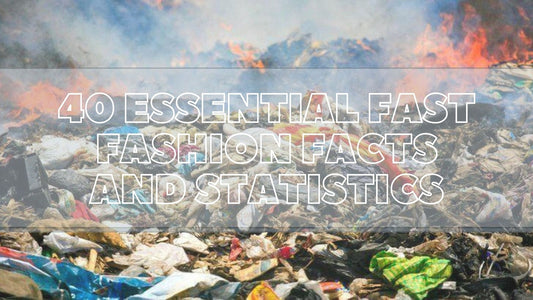40 Essential Fast Fashion Facts and Statistics

Fast fashion is a huge and growing industry with an outsized impact on the planet.
Despite a growing number of consumers expressing a desire for more sustainably, ethically sourced clothing, a quick look at the most essential fast fashion facts paints a grim picture.
Before we take a look at some striking fast fashion statistics, let's clear up what we mean by fast fashion.
Fast fashion is an umbrella term for mass-produced clothing, sold cheaply and quickly disposed of.
Globalization enables well-known clothing brands to quickly meet the demand for throwaway clothing, as new trends take center stage. Fast fashion is all about keeping up with those trends, in a market that values here today, gone tomorrow fashions.
Primarily produced in developing countries using cost-cutting techniques that pay little regard to the environment and employee welfare, fast fashion is attracting growing scrutiny from consumers and campaigners looking to build a more sustainable future.
We’re going to take a look at 40 eye-popping facts about fast fashion to understand how this industry impacts the planet and the people who work in it.
Overview: 40 Essential Fast Fashion Facts and Statistics
1. Measured as a national GDP, the fashion industry is the 7th biggest GDP at $2.4 trillion.
2. 1 in 6 global workers are employed in the garment industry.
3. 56% of all clothing sold in the USA was made in America before 2000. By 2012, just 2.5% of clothing worn by Americans was made in America.
4. In the mid-1990s, Americans averaged 28 garment purchases per year. By 2018, the average was 68 garments annually.
5. Average American disposed of 8 trash bags (82 pounds) worth of clothing in 2016.
6. $500 billion of potential value is lost every year due to a failure to recycle or fully utilize clothing.
7. It costs $20.6 million annually for New York to transport textiles to waste disposal facilities.
8. 60% of garments produced every year end up in landfills.
9. Fashion is the second biggest polluter on the planet. Only the oil industry pollutes more.
10. Fashion manufacturing accounts for 10% of annual global carbon emissions.
11. If the 14 million tons of clothing trashed in the US in 2016 were recycled, it would have the same benefit as removing 7.3 million cars from roads.
12. Clothing that is worn less than 5 times and disposed of within 35 days (i.e. fast fashion), generates 400% more carbon than an item worn 50 times and retained for a year.
13. 60% of garments were made with polyester. Polyester is three times more carbon-intensive than cotton.
14. Up to 35 percent of microplastics in the world's oceans come from fashion manufacturing. Polyester accounts for 73% of that.
15. A 2017 study found microplastics in 83% of tap water samples taken in 5 continents.
16. Polyester production uses nearly 70 million barrels of oil every year.
17. 20-200 years is how long it takes polyester in landfills to decompose.
18. The fashion industry is the 2nd largest consumer of water resources.
19. It takes 1,800 gallons of water to produce and clean one pair of the world’s favorite trousers.
20. Approximately 1.1 billion people globally have no access to water.
21. The Aral Sea lost 90% of its volume in just 50 years, after 2 rivers feeding it were diverted for cotton farms.
22. The clothing industry is responsible for 20% of global wastewater, primarily from textile dyeing.
23. Cotton production is responsible for 16% of all pesticide usage globally.
24. To facilitate the production of cellulosic fabrics (including cotton, hemp, linen, and rayon), around 200 million trees are felled every year.
25. Clothing manufacturing will swallow up an additional 35% of land (115 million hectares) to meet increased demand for fiber production.
26. Just 2% of garment workers earn a living wage.
27. 77% of leading retailers in the UK, including large clothing retailers, thought it likely that modern slavery occurred somewhere in their supply chains.
28. A 2018 US Department of Labor report found evidence of forced and/or child labor in the garment industry in Argentina, Bangladesh, Brazil, Burma, China, India, Malaysia, Thailand, Turkey, and Vietnam.
29. Around 400,000 children — half under 14 — were found to be working in cotton fields in the 4 states of India that account for 90% of India’s cotton production.
30. 33% of (female) workers had fainted at work, while 28% had received a glucose drip in the previous year.
31. The global apparel market is projected to grow 67% from 2020 to 2025.
32. The fast fashion market specifically is projected to grow from 30.58 billion USD in 2021 to 39.84 billion USD in 2025.
33. Looking ahead to 2030, it is projected that we will consume 102 million tons of apparel, up from 62 million tons.
34. Shein — known as an ‘ultra-fast fashion’ manufacturer in China — regularly introduces more than 6,000 new products per day.
35. CO2 output from the clothing industry is predicted to rise 49% by 2030.
36. 72% of Americans are aware of sustainability issues in the apparel industry.
37. 55% are interested in buying more sustainably-sourced clothing, yet 48% are unsure where to find more sustainable clothing.
38. Two-thirds of apparel shoppers say that sustainability is more important to them today than it was before the Covid-19 crisis.
39. 55% of consumers expect clothing brands to care for the health of their employees.
40. 88% of consumers do not trust clothing brands that claim to source more sustainably.
The Fast Fashion Industry in Numbers

1. Measured as a national GDP (Gross Domestic Product), the fashion industry is the 7th biggest GDP at $2.4 trillion – that’s an economy bigger than Brazil’s and similar to France and the United Kingdom. Although luxury fashion remains the biggest sector. [1]
2. 1 in 6 global workers are employed in the garment industry. [2]
3. According to the Bureau of Labor Statistics, 56% of all clothing sold in the USA was made in America before 2000. That figure fell off a cliff in the ensuing years as fast fashion became more popular. By 2012, just 2.5% of clothing worn by Americans was made in America. [2]
4. That does not mean Americans are buying less clothing. In the mid-1990s, Americans averaged 28 garment purchases per year. By 2018, the average was 68 garments annually. This is driven by the fact that the average item of clothing is worn just seven times. [2]
5. Limited reuse is a key attribute of fast fashion, which is why the average American disposed of 8 trash bags (82 pounds) worth of clothing in 2016. This equates to 14 million tons of clothing waste annually in the US alone, double what it was 20 years earlier. [3]
6. The Ellen MacArthur Foundation — a charity founded committed to building a more circular economy— estimates that $500 billion of potential value is lost every year due to a failure to recycle or fully utilize clothing. [4]
7. Everyone pays for fast fashion, even if you buy more durable garments. An example of this is the $20.6 million annual bill for New York to transport textiles to waste disposal facilities. [3]
8. Even though options are available to recycle used clothing, about 60% of garments produced every year end up in landfills. [5]
The Environmental Impact of Fast Fashion
As you might expect from a global business model built around fast turnarounds and driving down manufacturing costs, the ecological impact of fast fashion is massive. Here are some alarming facts about fast fashion and the industry’s ecological impact on our planet.
9. Fashion is the second biggest polluter on the planet. Only the oil industry pollutes more. One of those fast fashion statistics that speaks volumes. [6]
10. Fashion manufacturing accounts for 10% of annual global carbon emissions. This is more than all the international flights and maritime shipping combined. It is similar to the total annual output of greenhouse gases for the entire European Union. [7]
11. If the 14 million tons of clothing trashed in the US in 2016 were recycled, it would have the same benefit as removing 7.3 million cars from roads. [3]
12. In simple terms, keeping an item of clothing for longer is better for the planet. Clothing that is worn less than 5 times and disposed of within 35 days (i.e. fast fashion), generates 400% more carbon than an item worn 50 times and retained for a year. [8]
Polyester Garments Have a Disproportionate Impact on the Environment
Polyester is cheap to produce, making it a widely-used fabric in fast fashion. As of 2015, 60% of garments were made with polyester. A 157% increase since 2000.
As the next five fast fashion facts demonstrate, polyester has a hugely negative impact on our fragile ecosystem.
13. The most telling statistic is that polyester is three times more carbon-intensive than cotton. [9]
14. Up to 35 percent of microplastics in the world's oceans come from fashion manufacturing. Polyester is the worst offender, generating 73% of the total textile microplastic pollution. [10]
15. It’s not just the oceans that are suffering. Microplastics are turning up in the water we drink, and just about everywhere else, from food, beverages, and even in the air that we breathe. A 2017 study found microplastics in 83% of tap water samples taken in 5 continents. [11]
16. We probably all know that cars are contributing to greenhouse emissions. But one of the most surprising fast fashion facts is that polyester production uses nearly 70 million barrels of oil every year. [12]
17. 20-200 years is how long it takes polyester in landfills to decompose. [13]
Facts About Fast Fashion and Unsustainable Cotton Production
Alongside polyester, cheap cotton plays a big role in fast fashion. While it is possible to source cotton from sustainable farms like we do at Big Frenchies, the vast majority of cotton comes from farms that do not prioritize sustainable production.
And it is the planet’s water resources that are suffering, as the following fast fashion statistics illustrate.
18. The fashion industry is the 2nd largest consumer of water resources. Only fruit and vegetable farming uses more. Remarkably, even the beverage industry uses less (4th highest consumer). [14]
19. For a prime example of how fashion guzzles water, look no further than a pair of everyday jeans. It takes 1,800 gallons of water — with some estimates putting the figure at 2,600 gallons — to produce and clean one pair of the world’s favorite trousers. [6]
20. Here’s the thing, water scarcity is a problem affecting billions. Approximately 1.1 billion people globally have no access to water (out of a total of 2.7 billion who experience water scarcity). [15]
21. One environmental disaster puts it all these facts about fast fashion in perspective, the fate of The Aral Sea in Uzbekistan. The lake lost 90% of its volume in just 50 years, after 2 rivers feeding it were diverted for cotton farms. [16]
The Wider Ecological Footprint of Fast Fashion
While the growing demand for cotton created by fast fashion is putting pressure on water resources in countries that need it most, the environmental impact of fast fashion does not end there. 
22. The clothing industry is also responsible for 20% of global wastewater, primarily from textile dyeing. [7]
23. Cotton production is responsible for 16% of all pesticide usage globally, the highest use by any individual crop. [17]
24. To facilitate the production of cellulosic fabrics (including cotton, hemp, linen, and rayon), around 200 million trees are felled every year. It is estimated that over 35% of trees are from long-standing woodlands. [18]
25. A UK Parliamentary report estimated that clothing manufacturing will swallow up an additional 35% of land (115 million hectares) to meet increased demand for fiber production. [19]
The Human Cost of Fast Fashion
“Fast fashion isn’t free. Someone, somewhere is paying” – Lucy Siegle (Environmental writer and journalist)
Cheaply manufactured clothing from developing countries has a human cost felt by millions of workers. The next set of fast fashion facts paints a picture of an industry that consistently puts the bottom line first, often at the expense of employee welfare.
26. According to the Wall Street Journal, just 2% of garment workers earn a living wage. [20]
In Bangladesh — home to the 2nd largest garment industry (after China) — garment workers typically earn the minimum wage of $96 (USD) per month. Yet Global Living Wage estimates the living wage in Bangladesh to be between $334(USD) and $403 (USD) per month for a family.
27. One of the more shocking fast fashion facts is that 77% of leading retailers in the UK, including large clothing retailers, thought it likely that modern slavery occurred somewhere in their supply chains. [21]
28. Needless to say, many workers in the clothing industry will welcome more ethical sourcing in the clothing industry. A 2018 US Department of Labor report found evidence of forced and/or child labor in the garment industry in Argentina, Bangladesh, Brazil, Burma, China, India, Malaysia, Thailand, Turkey, and Vietnam. [22]
29. To give those figures some substance, consider these two examples:
Around 400,000 children — half under 14 — were found to be working in cotton fields in the 4 states of India that account for 90% of India’s cotton production. [23]
While in Uzbekistan, many schoolchildren are forced to work in cotton fields during harvest, which lasts 1-2 months. [24]
30. The demands of fast fashion exact a real human toll. The need to meet spikes in demands means many garment workers are subject to volatile working hours, often leading to overwork.
One survey of workers in two garments factories in India found that 33% of (female) workers had fainted at work, while 28% had received a glucose drip in the previous year. [25]
Fast Fashion Statistics - Looking Ahead
Despite the clear impact on the planet and the people working within the clothing manufacturing, fast fashion is pushing extraordinary growth in the industry. Just a quick look at projected fast fashion statistics shows just how unstoppable the fast fashion juggernaut is.
31. According to the number crunchers at Statista, the global apparel market is projected to grow 67% from 2020 to 2025. [26]
32. The fast fashion market specifically is projected to grow from 30.58 billion USD in 2021 to 39.84 billion USD in 2025. [27]
33. Looking ahead to 2030, it is projected that we will consume 102 million tons of apparel, up from 62 million tons. Partly a consequence of global population increases, but mostly due to rising individual consumption. That’s a lot more clothes heading to landfills… [4]
34. To illustrate just how much fashion has changed in recent years, Shein — known as an ‘ultra-fast fashion’ manufacturer in China — regularly introduces more than 6,000 new products per day. Guided by customer data, they can turn a new design into a sellable product in just three days. [1]
35. No surprise, the planet will pay a price for this continuing expansion. CO2 output from the clothing industry is predicted to rise 49% by 2030. [28]
A Better Future for Fast Fashion?
You might be asking yourself if there is any good news to be found in amongst the latest fast fashion facts. Happily, there is.
Some current fast fashion statistics point to a potentially brighter future, largely driven by socially-aware consumers nudging retailers to do better.
36. According to a 2021 survey of 2,000 shoppers, 72% of Americans are aware of sustainability issues in the apparel industry. [29]
37. 55% are interested in buying more sustainably-sourced clothing, yet 48% are unsure where to find more sustainable clothing. [29]
38. Retailers are finally waking up to their responsibilities, especially after the covid pandemic. Two-thirds of apparel shoppers say that sustainability is more important to them today than it was before the Covid-19 crisis. [30]
39. In a growing sign of consumers recognizing that fast fashion has a human cost, 55% of consumers expect clothing brands to care for the health of their employees. [30]
40. If there is one thing sure to get clothing CEOs thinking about change, it is brand reputation. There is a long way to go — a startling 88% of consumers do not trust clothing brands that claim to source more sustainably. [29]
While most of these fast fashion facts suggest change will be slow, there are glimmers of light that point to a brighter future for fashion. The latest McKinsey report, ‘The state of fashion in 2022’ [30], includes this hopeful quote from Geraldine Wharrey, a fashion forecaster:
“I think we’re at a tipping point when it comes to people associating the item they buy with its contribution to society…”
It is this ethos that we embrace at Big Frenchies. We believe in offering consumers high-quality clothing while reducing our environmental footprint. We also believe in paying a fair price and doing the right thing for the people who make our products.
It is why all our clothing is made using sustainably-sourced organic cotton. This means we are using 50% less water, 50% less energy, and generating 46% less CO2 than other retailers.
Our clothing is certified by Global Organic Textile Standards (GOTS), an assurance that all the cotton we use is 100% organic. Importantly, it also checks that workers are paid a fair wage and treated with dignity and respect throughout the supply chain.
As this list of fast fashion facts has shown, it is down to retailers big and small to do better. And while the world of fashion has changed beyond recognition in the last 20 years, that change can’t come soon enough.
Despite all the bad things happening in the Fast Fashion Industry, Sustainable Fashion is gaining more popularity. Make sure to check out our 'Must-Know Sustainable Fashion Facts' post to learn more.
References:
1. State of Fashion 2022: An uneven recovery and new frontiers (McKinsey, 2022)
2. The High Price of Fast Fashion (WSJ, 2019)
3. Fast Fashion Is Creating an Environmental Crisis (Newsweek, 2019)
4. Fixing fashion: clothing consumption and sustainability (UK Parliamentary Report, 2019)
5. Waste and pollution (Clean Clothes Campaign)
6. What’s the Second Most Polluting Industry? (One Green Planet, 2021)
7. How Much Do Our Wardrobes Cost to the Environment? (World Bank, 2019)
8. Waste Wednesday Fast Fashion and Its Impacts (GenEco)
9. Materials Index: Polyester (Council of Fashion Designers of America)
10. Microplastics found across the Arctic may be fibres from laundry (New Scientist, 2021)
11. Synthetic Polymer Contamination in Global Drinking Water (Orb Media, 2017)
12. Can fashion ever be sustainable? (BBC, 2020)
13. Materials that linger: An embodied geography of polyester clothes (University of Wollongong, 2017)
14. Top 5 Industries with the Highest Water Consumption (Smarter Business, 2021)
15. Water Scarcity | Threats (World Wildlife Fund)
16. Aral Sea | Description, History, Map, Shrinking, & Facts (Encyclopedia Britannica)
17. The Deadly Chemicals in Cotton (Environmental Justice Foundation)
18. Transforming supply chains and taking Endangered Forests out of fabric (Canopy Planet)
19. Fashion’s environmental price tag (parliament.uk)
20. The High Price of Fast Fashion (wsj.com)
21. Corporate Leadership on Modern Slavery (Ethical Trade, 2016)
22. 2018 List of Goods Produced by Child Labor or Forced Labor (DoL, 2018)
23. The task of protecting India's child cotton pickers (BBC, 2014)
24. 2020 third-party monitoring of child labour and forced labour during the cotton harvest in Uzbekistan (International Labor Organization, 2021)
25. End Gender Based Harassment and Violence (Global Labor Justice, 2019)
26. Global apparel market - statistics & facts (Statista, 2022)
27. Fast Fashion Global Market Report 2021 (Research and Markets, 2021)
28. Measuring Fashion: Insights from the Environmental Impact of the Global Apparel and Footwear Industries (Quantis, 2020)
29. Survey: 1 in 3 U.S. Consumers Would Do All Their Shopping At A Sustainable Clothing Store, If Only One Existed (Genomatica, 2021)
30. The State of Fashion 2021 (McKinsey, 2021)








